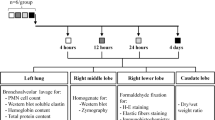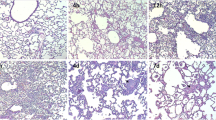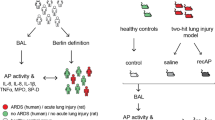Abstract
The aim of this study was to evaluate the concentrative relationship between polymorphonuclear elastase (PMNE) and urinary trypsin inhibitor (UTI) in the bronchoalveolar lavage fluid (BALF) of patients with acute respiratory distress syndrome (ARDS). A total of eight patients who developed ARDS after gastroenterological surgery and eight patients with normal respiratory function during general anesthesia using tracheal intubation were the subjects of this study. BALF was collected from the right middle lobe using saline, and the PMNE and UTI concentrations were measured. The PMNE concentrations were 1277 ± 1589 ng/ml and 38 ± 26 ng/ml in the patients with ARDS and those with normal lung function, respectively, and the UTI concentrations were 225 ± 175 mU/ml and 81 ± 40mU/ml, respectively, expressed as mean ± SD. Based on the UTI concentration which can inhibit PMNE activity, the PMNE concentration in the ARDS patients was not entirely inhibited by UTI. Since only UTI can inhibit PMNE activity in the inflammatory tissues, PMNE in the BALF may induce and aggravate lung injury in ARDS. Thus, we conclude that PMNE released from activated neutrophils in the lung is associated with the development of ARDS.
Similar content being viewed by others
References
Holman JM Jr, Saba TM (1988) Hepatocyte injury during postoperative sepsis: activated neutrophils as potential mediators. J Leukocyte Biol 43:193–203
Goldblum SE, Cohen DA, Gillespie MN, McClain CJ (1987) Interleukin-1-induced granulocytopenia and pulmonary leukostasis in rabbits. J Appl Physiol 162:122–128
Guice KS, Oldham KT, Johnson KJ, Kunkel RG, Morganroth M, Ward PA (1988) Pancreatitis-induced acute lung injury: an ARDS model. Ann Surg 208:71–77
Jaeschke H, Farhood A (1991) Neutrophil and Kupffer cellinduced oxidant stress and ischemia-reperfusion injury in rat liver. Am J Physiol 260:G355-G362
Sameshima H, Ikei S, Mori K, Yamaguchi Y, Egami H, Misumi M, Moriyasu M, Ogawa M (1993) The role of tumor necrosis factor-α in the aggravation of cerulein-induced pancreatitis in rats. Int J Pancreatol 14:107–115
Oka Y, Murata A, Nishijima J, Ogawa M, Mori T (1993) The mechanism of hepatic cellular injury in sepsis: an in vitro study of the implications of cytokines and neutrophils in its pathogenesis. J Surg Res 55:1–8
Sugita H, Yamaguchi Y, Ikei S, Yamada S, Ogawa M (1997) Enhanced expression of cytokine-induced neutrophil chemoattractant (CINS) by bronchoalveolar macrophages in ceruleininduced pancreatitis rats. Dig Dis Sci 42:154–160
Lee CT, Fein AM, Lippmann M, Holtzman H, Kimbel P, Weinbaum G (1981) Elastolytic activity in pulmonary lavage fluid from patients with adult respiratory distress syndrome. N Engl J Med 304:192–196
Mcguire WW, Spragg RG, Cohen AB, Cochrane CG (1982) Studies on the pathogenesis of the adult respiratory distress syndrome. J Clin Invest 69:543–553
Balk RA, Jacobs RF, Tryka AF, Townsend JW, Walls RC, Bone RC (1988) Effects of ibuprofen on neutrophil function and acute lung injury in canine endotoxin shock. Crit Care Med 16:1121–1127
Ogawa M (1996) Mechanisms of the development of organ failure following surgical insult: The “second attack” theory. Clin Intensive Care 7:34–38
Ishizaki T, Ohnishi T, Sakai T (1993) Dynamic changes of polymorphonuclear cell elastase-α1-protease inhibitor complex, a stress marker, in various pulmonary diseases (in Japanese with English abstract). Rynsho Byori (Jpn J Clin Pathol) 41:147–153
Jönsson BM, Ohlsson K (1984) Interactions of the complex between human urinary trypsin inhibitor and human leukocyte elastase with α1-proteinase inhibitor and α2-macroglobulin. Hoppe-Seyler’s Z Physiol Chem 365:1403–1408
Ogawa M, Nishibe S, Mori T, Neumann S (1987) Effects of human urinary trypsin inhibitor on granulocyte elastase activity. Res Commun Chem Pathol Pharmacol 55:271–274
Ishikawa A, Fukao K, Tsuji K, Osada A, Yamamoto Y, Iwasaki Y (1993) Can ulinastatin be an effective inhibitor of human polymorphonuclear granulocyte elastase under severe stressed state? (in Japanese with English abstract). Nihhon Geka Gakkai Zasshi (J Jpn Surg Soc) 94:449–455
Bernard GR, Artigas A, Brigham KL, Carlet J, Falke K, Hudson L, Lamy M, Legall JR, Morris A, Spragg R (1994) The American-European consensus conference on ARDS: definitions, mechanisms, relevant outcomes, and clinical trial coordination. Am J Respir Crit Care Med 149:818–824
Yoshida E, Sumi H, Maruyama M, Mihara H, Sakai R (1987) Development and application of an enzyme-linked immunosorbent assay for acid stable trypsin inhibitor (ASTI) in human plasma. Clin Chim Acta 167:155–164
Dillard GHL (1950) The trypsin inhibitor for the urine in health and disease. J Lab Clin Med 36:266–271
Yoshida E, Sumi H, Maruyama M, Tsushima H, Matsuoka Y, Sugiki M, Mihara H (1989) Distribution of acid stable trypsin inhibitor immunoreactivity in normal and malignant human tissues. Cancer 64:860–869
Dent G, Rabe KF, Magnussen H (1995) Relationship between bronchoalveolar lavage neutrophil numbers and lavage fluid elastase and antielastase activities. Lung 173:165–175
Faarvang HJ (1963) Dose-response between exogenous cortisone acetate and the urinary excretion of trypsin inhibitor in man. Acta Endocrinol 43:484–492
Kaumeyer JF, Polazzi JO, Kotick MP (1986) The mRNA for a proteinase inhibitor related to the HI-30 domain of inter-α-trypsin inhibitor also encodes α-1-microglobulin (protein HC). Nucleic Acids Res 14:7839–7850
Sugiki M, Sumi H, Maruyama M, Yoshida E, Mihara H (1989) Clearance and distribution of acid-stable trypsin inhibitor (ASTI). Enzyme 42:31–38
Ohnishi H, Kosuzume H, Ashida Y, Kato K, Honjo I (1984) Effects of urinary trypsin inhibitor on pancreatic enzymes and experimental acute pancreatitis. Dig Dis Sci 29:26–32
Ohnishi H, Suzuki K, Niho T, Ito C, Yamaguchi K (1985) Protective effects of urinary trypsin inhibitor in experimental shock. Jpn J Pharmacol 39:137–144
Aoike I, Takano Y, Gejyo F, Arakawa M (1989) Ulinastatin gives rise to an effectual diuresis in oliguric acute renal failure. Nephron 52:368–369
Sunami K, Kimura M, Takeda A (1997) Three cases of severe bronchial asthma attacks successfully treated with transbronchial administration of ulinastatin (in Japanese with English abstract). Rynsho Masui (J Clin Anesth (Jpn)) 21:616–620
Author information
Authors and Affiliations
Rights and permissions
About this article
Cite this article
Nakane, M., Iwama, H. Intra-alveolar urinary trypsin inhibitor cannot inhibit polymorphonuclear elastase activity in the lung in postsurgical patients with acute respiratory distress syndrome. Surg Today 29, 1030–1033 (1999). https://doi.org/10.1007/s005950050640
Received:
Accepted:
Issue Date:
DOI: https://doi.org/10.1007/s005950050640




